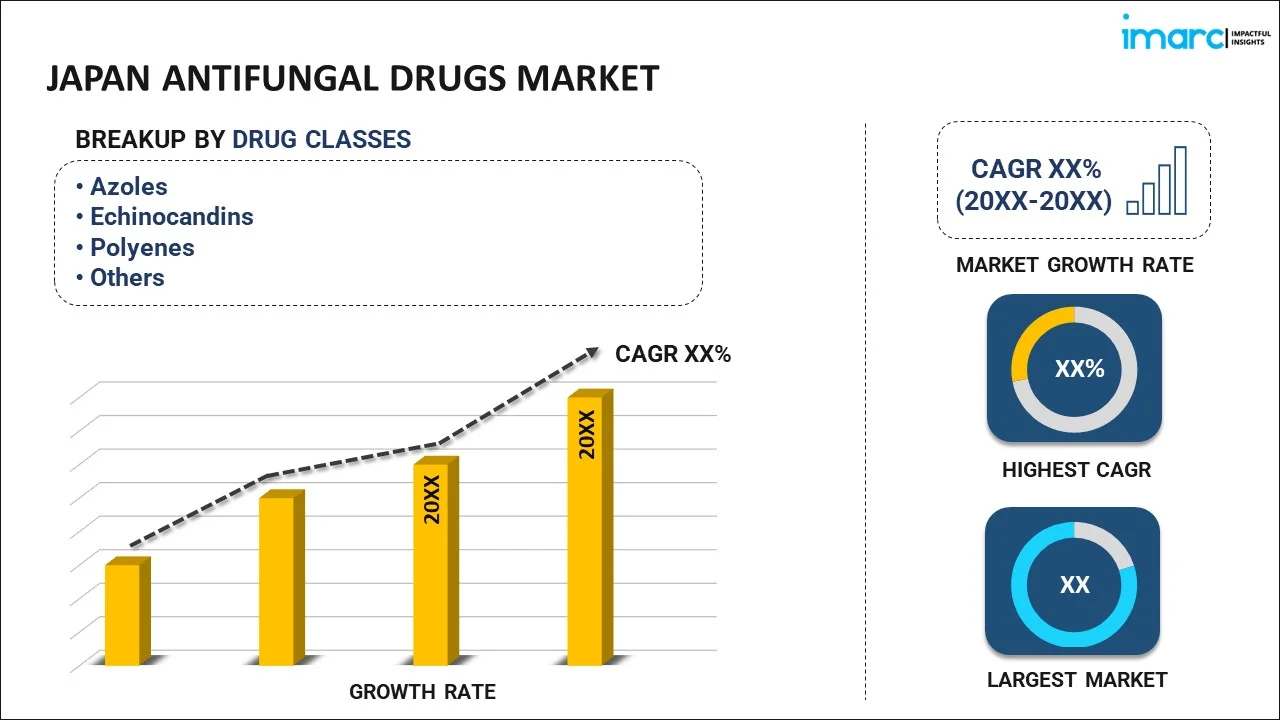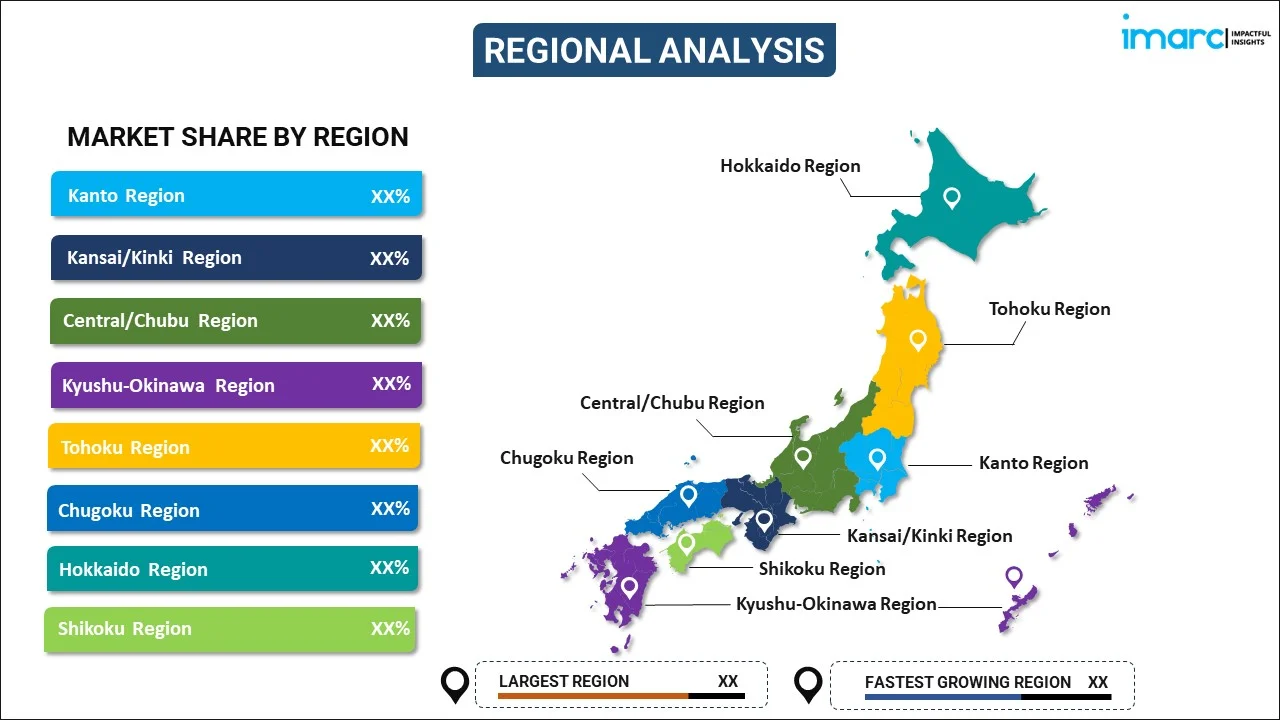
Japan Antifungal Drugs Market Report by Drug Classe (Azoles, Echinocandins, Polyenes, Allylamines, and Others), Indication (Dermatophytosis, Aspergillosis, Candidiasis, Others), and Region 2025-2033
Market Overview:
Japan antifungal drugs market size reached USD 1.08 Billion in 2024. Looking forward, IMARC Group expects the market to reach USD 1.63 Billion by 2033, exhibiting a growth rate (CAGR) of 4.47% during 2025-2033. The increasing cases of fungal infections, attributed to several factors, such as a growing population of immunocompromised individuals, aging people, the widespread use of immunosuppressive drug, etc., are driving the market.
|
Report Attribute
|
Key Statistics
|
|---|---|
|
Base Year
|
2024 |
|
Forecast Years
|
2025-2033 |
|
Historical Years
|
2019-2024
|
| Market Size in 2024 | USD 1.08 Billion |
| Market Forecast in 2033 | USD 1.63 Billion |
| Market Growth Rate (2025-2033) | 4.47% |
Antifungal drugs are pharmaceutical compounds designed to combat fungal infections in humans, animals, and plants. Fungal infections can range from mild skin conditions to severe, life-threatening systemic illnesses. These drugs work by targeting various aspects of fungal cell growth and function, inhibiting their ability to replicate and spread. There are several classes of antifungal drugs, including azoles, polyenes, echinocandins, and allylamines. Azoles, such as fluconazole and itraconazole, interfere with fungal cell membrane synthesis. Polyenes, like amphotericin B, disrupt fungal cell membranes directly. Echinocandins, including caspofungin, inhibit cell wall formation. Allylamines, such as terbinafine, interfere with fungal enzyme activity. Choosing the appropriate antifungal drug depends on the type and severity of the infection, as well as the patient's health status. Some antifungals are available over-the-counter for topical use, while others require a prescription for systemic infections. It's crucial to use these drugs as prescribed to ensure effectiveness and minimize the risk of drug-resistant fungal strains emerging.
Japan Antifungal Drugs Market Trends:
The antifungal drugs market in Japan is poised for significant growth, primarily due to several interconnected factors. Firstly, the rising incidence of fungal infections serves as a crucial driver. As fungal pathogens become more resistant, the demand for innovative antifungal therapies intensifies. Moreover, the growing elderly population, often with compromised immune systems, increases susceptibility to fungal infections, further propelling market expansion. Secondly, advancements in medical research and biotechnology have paved the way for novel antifungal drug development. Breakthroughs in understanding fungal biology and the discovery of new drug targets have led to a steady influx of innovative therapies. Consequently, pharmaceutical companies are investing heavily in R&D, fostering market growth. Additionally, the rising support from various governments and healthcare organizations in the form of funding and favorable policies to control the spread of fungal infections is expected to drive the antifungal drugs market in Japan during the forecast period.
Japan Antifungal Drugs Market Segmentation:
IMARC Group provides an analysis of the key trends in each segment of the market, along with forecasts at the country level for 2025-2033. Our report has categorized the market based on drug class and indication.
Drug Class Insights:

- Azoles
- Voriconazole (Vfend)
- Posaconazole (Noxafil)
- Clotrimazole (Canesten)
- Isavuconazole (Cresemba)
- Others
- Echinocandins
- Caspofungin (Cancidas)
- Micafungin (Mycamine/ Funguard)
- Others
- Polyenes
- Amphotericin (AmBisome)
- Others
- Allylamines
- Terbinafine (Lamisil)
- Others
- Others
The report has provided a detailed breakup and analysis of the market based on the drug class. This includes azoles (voriconazole (vfend), posaconazole (noxafil), clotrimazole (canesten), isavuconazole (Cresemba), and others), echinocandins (caspofungin (cancidas), micafungin (mycamine/ funguard), and others), polyenes (amphotericin (ambisome) and others), allylamines (terbinafine (lamisil) and others), and others.
Indication Insights:
- Dermatophytosis
- Aspergillosis
- Candidiasis
- Invasive Candidiasis
- Vulvovaginal Candidiasis (VVC)
- Mouth/Throat/Esophageal Candidiasis
- Others
- Others
A detailed breakup and analysis of the market based on the indication have also been provided in the report. This includes dermatophytosis, aspergillosis, candidiasis (invasive candidiasis, vulvovaginal candidiasis (VVC), mouth/throat/esophageal candidiasis, and others), and others.
Regional Insights:

- Kanto Region
- Kansai/Kinki Region
- Central/ Chubu Region
- Kyushu-Okinawa Region
- Tohoku Region
- Chugoku Region
- Hokkaido Region
- Shikoku Region
The report has also provided a comprehensive analysis of all the major regional markets, which include Kanto Region, Kansai/Kinki Region, Central/ Chubu Region, Kyushu-Okinawa Region, Tohoku Region, Chugoku Region, Hokkaido Region, and Shikoku Region.
Competitive Landscape:
The market research report has also provided a comprehensive analysis of the competitive landscape. Competitive analysis such as market structure, key player positioning, top winning strategies, competitive dashboard, and company evaluation quadrant has been covered in the report. Also, detailed profiles of all major companies have been provided.
Japan Antifungal Drugs Market Report Coverage:
| Report Features | Details |
|---|---|
| Base Year of the Analysis | 2024 |
| Historical Period | 2019-2024 |
| Forecast Period | 2025-2033 |
| Units | Billion USD |
| Scope of the Report | Exploration of Historical Trends and Market Outlook, Industry Catalysts and Challenges, Segment-Wise Historical and Future Market Assessment:
|
| Drug Classes Covered |
|
| Indications Covered |
|
| Regions Covered | Kanto Region, Kansai/Kinki Region, Central/ Chubu Region, Kyushu-Okinawa Region, Tohoku Region, Chugoku Region, Hokkaido Region, Shikoku Region |
| Customization Scope | 10% Free Customization |
| Post-Sale Analyst Support | 10-12 Weeks |
| Delivery Format | PDF and Excel through Email (We can also provide the editable version of the report in PPT/Word format on special request) |
Key Questions Answered in This Report:
- How has the Japan antifungal drugs market performed so far and how will it perform in the coming years?
- What has been the impact of COVID-19 on the Japan antifungal drugs market?
- What is the breakup of the Japan antifungal drugs market on the basis of drug class?
- What is the breakup of the Japan antifungal drugs market on the basis of indication?
- What are the various stages in the value chain of the Japan antifungal drugs market?
- What are the key driving factors and challenges in the Japan antifungal drugs?
- What is the structure of the Japan antifungal drugs market and who are the key players?
- What is the degree of competition in the Japan antifungal drugs market?
Key Benefits for Stakeholders:
- IMARC’s industry report offers a comprehensive quantitative analysis of various market segments, historical and current market trends, market forecasts, and dynamics of the Japan antifungal drugs market from 2019-2033.
- The research report provides the latest information on the market drivers, challenges, and opportunities in the Japan antifungal drugs market.
- Porter's five forces analysis assist stakeholders in assessing the impact of new entrants, competitive rivalry, supplier power, buyer power, and the threat of substitution. It helps stakeholders to analyze the level of competition within the Japan antifungal drugs industry and its attractiveness.
- Competitive landscape allows stakeholders to understand their competitive environment and provides an insight into the current positions of key players in the market.
Need more help?
- Speak to our experienced analysts for insights on the current market scenarios.
- Include additional segments and countries to customize the report as per your requirement.
- Gain an unparalleled competitive advantage in your domain by understanding how to utilize the report and positively impacting your operations and revenue.
- For further assistance, please connect with our analysts.
 Inquire Before Buying
Inquire Before Buying
 Speak to an Analyst
Speak to an Analyst
 Request Brochure
Request Brochure
 Request Customization
Request Customization




.webp)




.webp)












